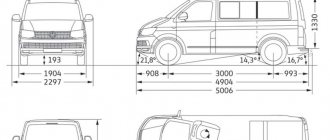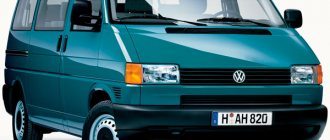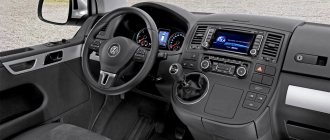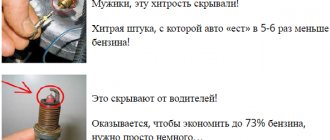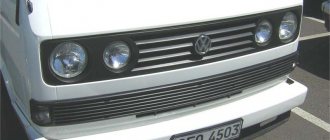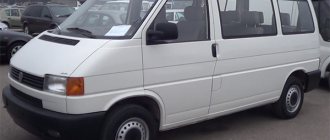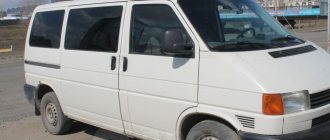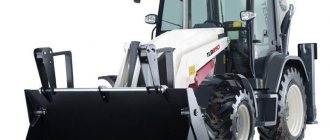After the 4th series of the modified Volkswagen Transporter was discontinued in 2003, the new Volkswagen Transporter T5 was released, which could boast both new improved characteristics and some retained old ones. As a result, we again saw the directions that came to us from the last series:
- Passenger Transportation;
- cargo and passenger transportation;
- freight transportation.
The changed technical characteristics allowed us to take a fresh look at the car presented to the general public. What has changed?
A lot of things:
- improved optics;
- increased tightness in the cabin, eliminated increased noise;
- increased carrying capacity by 180-300 kg;
- provided the opportunity to transport cargo with a trailer weighing up to 2.5 tons;
- increased overall dimensions by 20-30 cm;
- the cargo modification had swing gates;
- made a low landing to facilitate unloading and loading things;
- Installed a side sliding door for easy unloading.
Appearance
The fourth Transporter had a revolutionary design, however, we have to admit that the fifth generation had a real breakthrough in the design of the model range. The design has become so modern that in the latest generation it is not much different from the T5 design. The design of the entire model range of the German company has always been famous for its conservatism.
At the front, the Volkswagen Transporter T5 received a more elongated hood, which is also located at a large negative angle, the windshield and the A-pillar received a greater slope. The front optics have also been updated, which have a similar shape to the T4 optics, but have more rounded shapes and look much more relevant today, and in the restyling the model also received LED filling.
Most of the “front” of the car is now occupied by a huge front bumper with a false radiator grille located between the lights. It has a horizontal direction, and in its central part there is a large company logo. There are also air ducts in the middle part of the bumper, there are decorative grille panels for air ducts in the lower part of the Volkswagen Transporter T5 bumper, and in the corners there are small square niches for fog lights.
In profile, the car received extended wheel arches and new stampings. Otherwise the design remains the same. The car has acquired new side rear-view mirrors - previously they were vertically oriented, but now they are horizontally oriented. A wide molding runs along the threshold.
The rear part now, regardless of the modification, has two swing-opening doors. The rear bumper is U-shaped and modest in size. The vertically oriented lights are located on the side pillars and have three sections with a reversing light in the central part. On the left door there is a place for mounting a license plate, and on the right door there is a place for the company logo.
The T5 conveyor, depending on the modification, has an extended and standard version; three types of roof heights are also available:
- length – 4892 mm/5292 mm;
- width – 1904 mm;
- height – 1990-2476 mm;
- distance between axles – 3000 mm/3400 mm;
- load capacity up to 1600 kg.
Many secrets in a small cabin
The only thing missing in the cabin is sleeping places behind the seats. This van is from the daily category, that is, “day” vehicles, not designed for “lying down” rest. There’s even nowhere to recline the back of the driver’s seat; there’s a metal wall behind it. There is a certain amount of space to adjust the backrest tilt, but it is minimal. It is unlikely that you will be able to stretch out to your full height on three seats. The bed will be narrow, and the upholstery gets dirty easily. But here’s an important plus: under the double passenger seat there is something like... a refrigerator: in one of the two boxes there is an insert made of thick foam plastic. In general, a lot of stuff can fit under this seat, in addition to food and drinks. However, you can’t get all this on the go. In addition, the seat can be occupied by passengers, most likely just one, the “bench” is not that long, only 72 cm. I remember that in the UAZ “Profi” we were driving together with a colleague, and my dog fit between us. This option will not work here. In addition, the dog, as in the UAZ, will not be very comfortable climbing into these places. The “Transporter” is also very high in terms of landing; here you feel about the same (in relation to the ground) as in the “Gazelle Business”. True, in the latter the cabin is more spacious. But in terms of organizing space, Volkswagen is, of course, ahead.
Let's start the inspection from the top of the dashboard. On the left and right there are recesses-cup holders, small in diameter; a paper glass with a capacity of 0.5 liters from a roadside cafe can barely be held here. But there are other convenient places for such a glass, for example, the lower “pocket” in the inner panel of the door (there is also an upper one, under the handle, it is smaller). There is also a recess next to the gearbox joystick, but it is more convenient to use for a mobile phone. In theory, the phone can also be placed on a wide shelf directly behind the steering wheel, above the instrument panel. There is also a 12 V socket in the back, it is convenient to connect the wire for charging the gadget. You can also connect to Type C connectors if you have an appropriate adapter or a similar socket in your smartphone. In this regard, Volkswagen models are not very versatile. There is nowhere to connect a regular flash drive with music.
The shelf on top of the dashboard is convenient for documents. Two A4 stacks will fit with a guarantee. But if you need to sign papers on a shelf, this will not work. And the shelf in front of the passenger seats is too narrow.
The joystick lever is located extremely conveniently. “Gazelle-Next” did not come to this right away; initially they offered drivers a long pin sticking out of the floor, as in the previous “Gazelle” of the “Business” series. There are six gears in the “Transporter” box, and they are “associated” perfectly with the diesel engine, better than in the Caddy model, where the sixth gear is practically out of action.
The instrument panel in a commercial van seems to have a classic Volkswagen look, simple and clear. Electronics are the minimum; this is, in fact, the on-board computer screen, located between the large, clear scales of the speedometer and tachometer. Only on this screen we see one single image that cannot be changed: information about the air pressure in the tires. Useful information, of course, but I’m also interested in fuel consumption and other parameters... I devote some time to searching for a button for switching screens, but I still can’t find it. Subsequently it turns out that in this performance it is not there. Do you want to know the consumption? Select the appropriate option on the central screen. This is how travel information is presented here.
The manual transmission does not exclude cruise control, but on a winter road at a given 110 km/h it seems that the van is about to get out from under your feet. At the same time, “manually” you can easily drive it much faster: both at 130 and 150 km/h.
The menu is easy to understand, it is not rich. And the screen is monochrome and matte, and does not “blind” in the sun. Since I can’t play music from the flash drive I took with me, I connect my smartphone, but for some reason it constantly disconnects from the Volkswagen gadget. Almost every song interrupts the Bluetooth connection, and then spends a long time trying to restore it. Sometimes it works, sometimes you have to force it manually. In general, happiness comes only in the near Moscow region, where your favorite music radio can be heard uninterruptedly.
Among the peculiarities of the landing, I note that the upper part of the inner door panel is located ... unusually low. Much more often the opposite happens. And the lowering narrow armrest between the driver and passenger seats, on the contrary, is a bit high. However, its height is adjustable.
The exterior mirrors are “spacious” and have parking sensors. But there is a serious lack of a camera that would help when reversing out of a parking space. Even if the cars standing nearby are much shorter, the road is completely invisible. Considering that there are unlikely to be many people willing to let the “merchant” out, I go out, control the situation visually and, taking advantage of the pause in traffic, reverse into the street. Go
Modifications
The car is available in two lengths and three roof heights. The car also has a huge number of other body variations:
- closed van;
- minibus with the ability to transport nine people;
- cargo platform with 2-door cabin;
- cargo platform with 4-door cab;
- cargo platform with sides;
- conversion into an ambulance, refrigerator, cash-in-transit vehicle and other special services;
- model with sliding doors replaced with regular ones;
- model prepared for camping.
Volkswagen Transporter T5 interior
The West car and interior are imbued with German practicality. The first copies had a slightly sparse design, but after restyling the model received a completely new and modern interior, which is relevant even today. Among the disadvantages it has is thin and cheap plastic, which should rumble on any uneven surfaces, however, competent German engineers equipped everything with a large amount of sealing, which gives maximum comfort for commercial vehicles.
Modifications with cargo platforms have a more sparse interior than passenger versions.
The driver's seat is well equipped, and overall ergonomics are at the highest level. From the driver's seat it is not difficult to reach any controls. The steering wheel is 3-spoke with a modern design and a large number of buttons. In the center it is decorated with a small company emblem, and behind the steering wheel there is a colored instrument panel with red arrows and a large on-board computer display. All this is protected from solar blocks by a huge rounded visor.
The center console, descending, goes into a semi-horizontal position. At the highest point there is a small niche for documents, followed by a large display of the Volkswagen Transporter T5 multimedia system, on the sides of which there are air ducts with a vertical orientation. The climate system control unit fits very organically in the center, and on the sides there is a scattering of identical keys for controlling the functions of the car. The gearshift knob is also located on the dashboard, which makes the front floor absolutely flat, despite the modification of the car.
As standard, the seats have fabric upholstery, but leather is also available for the passenger version. The seats themselves have a fairly rigid filling, pronounced lateral support and a suitable range of adjustments.
Two bases, two roofs - three versions
But let's go a little later, and first we'll load such a spacious body. You can’t carry air alone for a whole test week. Two-meter height, three-meter length of cargo space... yes, a small elephant will fit here! The cargo compartment volume of the L2H2 version is 7.8 cubic meters, the floor area is 5 square meters. Here it must be noted that the high roof (H2) is only available on cars with a long wheelbase (L2, 3.4 m). A low roof can be used on both long and short (L1, base size 3.0 m) cars. The height of examples with a low roof is almost 2 m, with a high one - also almost 2.5 m.
I load the cargo compartment with bags of food for poultry and rabbits, as well as three wheels from my own car and a lot of various household items. My car couldn’t accommodate so much, but in the Transporter all this luggage is simply lost. This guy is ready for much more serious work.
There is no need to fix the bags of food; they will not “ride” on the floor, the coating of which is non-slippery and rubberized. But if fixation is needed, special aluminum rails with sliding rings are stretched along the walls. And the rings themselves are convenient to move and fix at the right points, and to tie luggage to them with ropes or slings, too.
It’s nice that the inside of the body is trimmed with laminated plywood, and not simple, like the “French” ones, which gives their models, to put it mildly, an “inexpensive” look. In the Transporter, only the shelf above the cabin is not painted, access to which is only from the side of the body. Also, by the way, a decent container for all sorts of things. Theoretically, one could think about organizing a sleeping place here... Only the commercial body is “deaf”, there is not a single window in it, there are no heating devices, the ventilation is probably rather weak. In winter you can freeze, in summer you can boil. Although there is one convenience: several ceiling lamps, each of which turns on independently of the others. If you accidentally lock yourself in the back, you can find a way out.
There are two exits. On the right is a wide sliding door with a secure lock. There is even a pin to prevent it from sagging. The convenient handle allows you to close it from the inside.
The rear doors are hinged and symmetrical. They are made to the height of the enlarged body, and the frame around them is reinforced with powerful “kerchiefs”. Simple mechanisms allow you to unlock the doors and allow them to swing open 180 degrees. To do this, just press the plastic pad on the unit. Only on the right door such an overlay was in place, but on the left it was lost, and without it the mechanism would not budge. The closed doors are locked tightly and do not rattle while moving, but you have to slam them with all your heart.
The standard Transporter body of the test version was extended. The roof is plastic. It is attached to the metal of the body with numerous ties, however, it was possible to see that there are fewer of these ties than there are potential places for their installation. Apparently, the engineers calculated that this amount of fasteners is quite enough to prevent the roof from being blown off the car at high speed. And the tall van is quite loyal to high speeds.
There is only one “but”. It is advisable to clean the roof before driving in winter. Because not only soft and loose snow, but also ice can accumulate on it. Shortly before this, one of the test cars was damaged by a piece of such ice: it flew off the roof of the truck and hit the windshield. Immediately, many cracks appeared on it. If such a piece got into the hood or roof, dents and scratches would form, and this is already an insured event. In general, it’s unpleasant.
The trouble is that you can’t sweep away the snow or the ice from the roof of the tall Transporter. The telescopic brush is missing. It barely even reaches the “forehead” above the windshield, let alone the roof, which doesn’t reach at all. What to do? Should I use some special brush with a three-meter folding handle? Or take a stepladder with you? I remember that, having owned a GAZ Sobol, I managed to clean a significant part of the roof from the ground with an ordinary brush, and even though the cleaning was hampered by the trunk mounted on top. It turns out that "Transporter" is higher.
Specifications
The car, following traditions, also has a huge range of power plants installed on it. Among them there are both diesel and gasoline engines. It’s worth starting with the second ones:
The first in the line can be considered a 2-liter capacity, which develops 115 “forces” and 170 Nm of torque. The engine operates only with a 5-speed manual transmission, which distributes all torque only to the front wheels. The maximum speed of the Volkswagen Transporter T5 with such a tandem will be 151 km/h, and acceleration to 100 km/h will take at least 15 seconds. All this with a combined cycle consumption of 10.3 liters per 100 km.
The same 2-liter engine can be boosted to 150; 204 hp and 280; 350 Nm of torque. The first modification can only work with a 6-speed manual transmission, which transmits torque to the front wheels, but for the second modification, the well-known DSG robot is available, distributing power to all 4 wheels using the 4MOTION all-wheel drive system.
There is a “charged” modification, under the hood of which a V-shaped “six” with a volume of 3.2 liters is installed. The power of the “giant” is 235 hp and the torque is 315 Nm. In combination with a 6-speed manual transmission and all-wheel drive, this engine easily accelerates a passenger car to 100 km/h in 9.6 seconds, and the maximum speed exceeds 200 km/h. And fuel consumption in the combined cycle is only 10.3 liters per 100 km.
Diesel engines are more popular, among which are turbodiesel engines with a volume of 1.9 liters, 2.0 liters and 2.5 liters.
The basic one develops 84 hp. 220 Nm of torque, which allows the car to accelerate to 131 km/h. Next comes the engine with a power of 102 hp. and torque of 250 Nm. And a 2.5 engine developing up to 174 hp. But the highlight of the Volkswagen Transporter T5 diesel range was the two-liter biturbo engine, installed since 2009, with a power of 180 hp and a torque of 400 Nm. Acceleration to 100 km/h with it took 10.4 seconds, and the top speed was 188 km/h.
All diesel engines in the combined cycle consumed no more than 7-9 liters of “heavy” fuel per 100 km/way, and they could work either in tandem with a 6-speed automatic transmission or with a 6-speed manual transmission. Power could be distributed both to the front wheels and to all four wheels.
The suspension was completely independent. MacPherson struts were installed at the front, and multi-link architecture at the rear. The steering is complemented by a hydraulic booster, and the brakes are all disc with ventilation at the front.
Engine and gearbox T5
Volkswagen Transporter T5 engines have an expanded range of petrol and diesel options.
Gasoline engines:
- with a volume of 2.0 they have a power of 115 horsepower and acceleration in 17.8 seconds to 100 km.
- with a volume of 3.2 they have a power of 235 horsepower and acceleration to 100 km in 10.5 seconds.
Diesel units:
- with a volume of 1.9 liters are available with power options of 84, 86, 102 and 105 horsepower;
- with a volume of 2.5 liters are produced with power from 131 to 174 horsepower.
Also, after certain modifications, you can find a turbodiesel with a volume of 2.0 liters and a power of 84, 102, 140 and 180 horsepower.
For different driving modes, two different types of transmission are installed, which affect fuel consumption:
- for high-speed cars it is a 6-speed manual transmission;
- standard ones have a 5-speed manual transmission.
For Transporter T5 fuses, 2 zones are allocated:
- in the cabin there are elements responsible for sensors and internal devices;
- in the engine compartment there are elements responsible for movement (brake locking system, pump and motor).
Malfunctions of Volkswagen Transporter T5
- A 4-cylinder diesel engine cannot cope with loads and often has problems with pump injectors;
- The 2.5 liter diesel engine is subject to early wear of liners and compensators;
- Every 100,000 km, the generator overrunning clutch “dies”;
- The biturbo version of the engine often has increased oil consumption;
- The flywheel often does not reach 20,000 km on the same biturbo engine;
- With regard to the transmission, problems arose only with the DSG robot, the owners of which, after 150,000 km, contacted the services, but there everything was done with a harmless flashing;
- The suspension will have to be “overhauled” every 150,000 km.
As for the body, owners complain about failure of power windows, leaking seals and rapid wear of the rollers on the side doors. The problem with corrosion resistance in the fifth generation has also not been resolved.
On the Russian market, pre-restyling models are sold in the price range of 500,000-700,000 rubles, and restyling will cost 900,000-1,400,000 rubles.
Despite its shortcomings, the Volkswagen Transporter T5 remains the same “workhorse”. This car with a powerful history was, is, and will continue to be appreciated.
Video
Compared to the previous generation, the Volkswagen Transporter minivan received updated headlights, a new front bumper, exterior mirrors, a radiator grille and a company logo design. In all modifications, emergency opening of the trunk doors from the inside has become available.
The Volkswagen Transporter minivan was produced with two-liter gasoline and diesel engines. Fuel consumption for gasoline versions (depending on engine power) is 12.8 - 14 liters in the city and 7.8 - 8.8 on the highway; for diesel versions it is slightly less: 9.6 - 10.3 liters in the city and 6.5 – 7.3 liters on the highway.
Dimensions
The Volkswagen Transporter T5 has body dimensions that are not very different from the T4 model. There are 3 types of proportions:
The length of the Volkswagen Transporter T5 can be of 2 types:
- standard – 4892 mm;
- extended – 5292 mm.
The height of the Volkswagen Transporter determines the total volume of the body and is manufactured in 2 types:
- average roof - 1990 mm (-566 ground clearance);
- high roof - 2176 (-566 ground clearance);
Volkswagen Transporter T5 wheel sizes are:
- diameter - 65.1;
- drilling - 5 x 120;
- nut - 14 x 1.5.
Basic tire configuration: 205/65 R16; 215/60 R17.
Possible replacement: 215/65 R16; 23/55 R17.
The weight of the Volkswagen Transporter T5 in running order is 1976 kg.
Chassis
The front suspension is independent, reinforced with a subframe in cargo models. The rear suspension is spring. Its rigidity varies depending on the parameters of the car. A stabilizer bar is also installed on the rear axles.
The brake system is disc. The front part is ventilated, with built-in ABS.
The basic design of the car is front-wheel drive. But in reinforced models, a viscous coupling is built in, which ensures that all-wheel drive is engaged in cases where the speed between the front and rear axles changes (slippage, uneven terrain, etc.). It should be noted that this unit is not repairable and must be replaced entirely.
Prices for new VW Transporter and used cars
In 2022, the cost of a VW Transporter on the primary market, depending on the configuration, ranges from 1 million 700 thousand rubles to 3 million 100 thousand rubles. The price of a used Transporter depends on the year of manufacture and can be:
- 1 million 200 thousand - a car manufactured in 2015;
- 950 thousand-1 million rubles - 2010–2012 model year;
- 500 thousand - 2003–2005 model year.
T5 2003 mileage 250,000, during all the time I changed the chassis, spark plugs and washer pump once, I won’t talk about maintenance. You don’t get tired while driving, you don’t feel the speed, you drive and relax behind the wheel. Advantages: excellent car, economical - 7l on the highway, 11l in winter. Disadvantages: expensive spare parts, BOSH heater, in winter only on winter diesel fuel, otherwise you fill it up - it gets blocked, you go to the computer, you can’t do it yourself.
Losev Vladimir
https://cars.mail.ru/reviews/volkswagen/transporter/2003/255557/
Video: first impressions of the Volkswagen T6
The Volkswagen Transporter has long earned a reputation as a car that is ideal for running small businesses, passenger transportation, delivering small cargo, etc. The closest competitors of the Volkswagen Transporter are Mercedes Vito, Hyundai Starex, Renault Trafic, Peugeot Boxer, Ford Transit, Nissan Serena. The VW Transporter cannot but attract with its efficiency, reliability, unpretentiousness, and ease of use. When releasing each new generation of Transporter, constructors and designers take into account current automotive fashion trends and strictly follow Volkswagen's signature style, which provides a minimum of external effects and a maximum of practicality and functionality.
